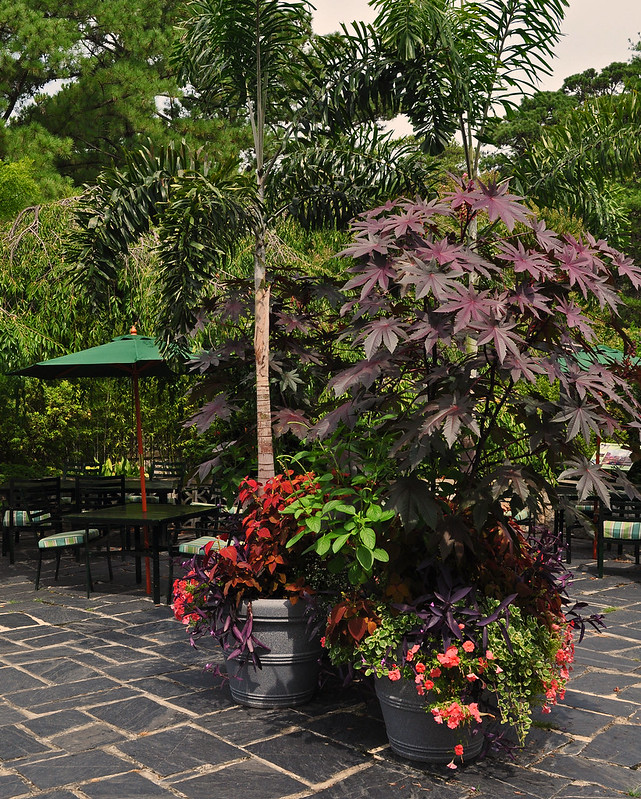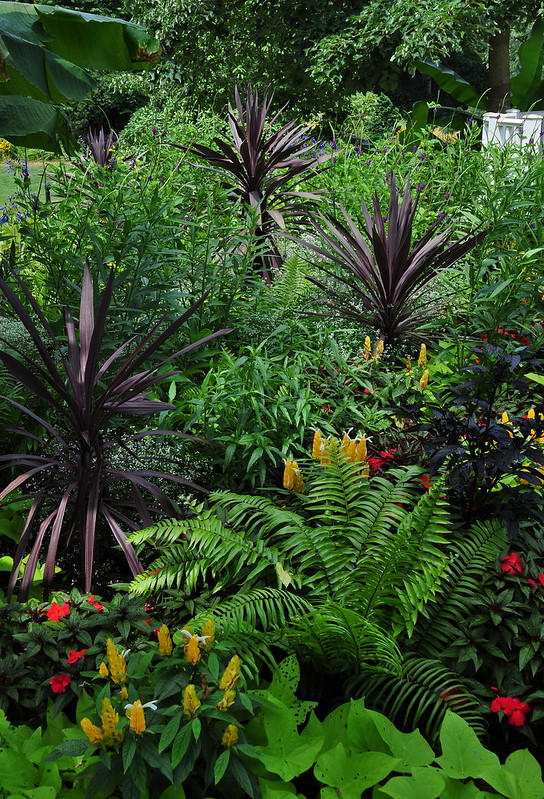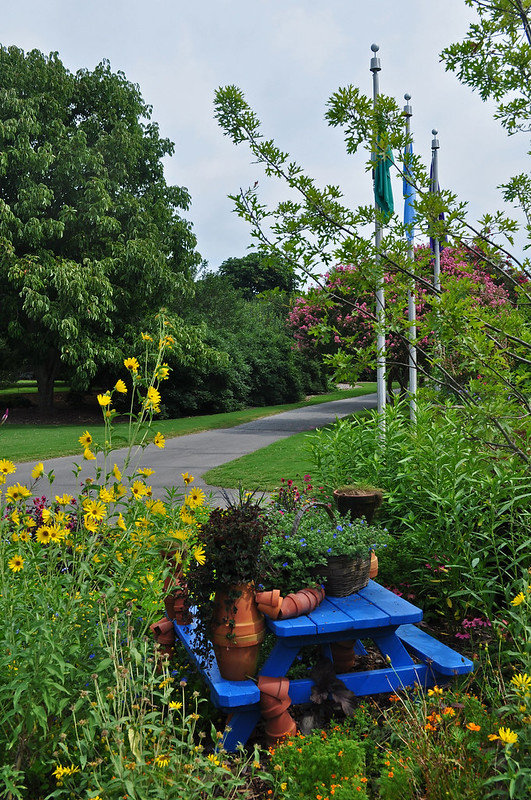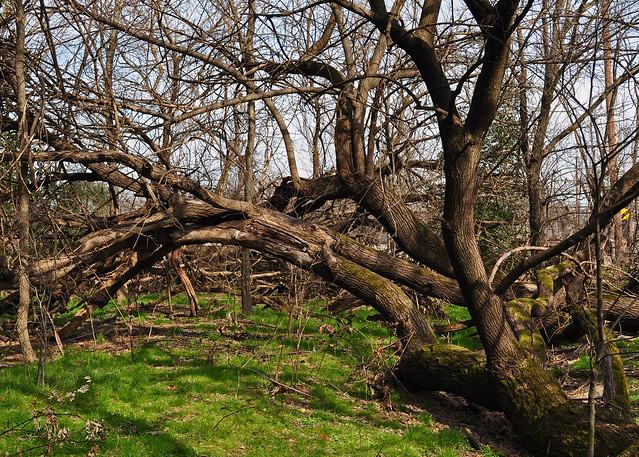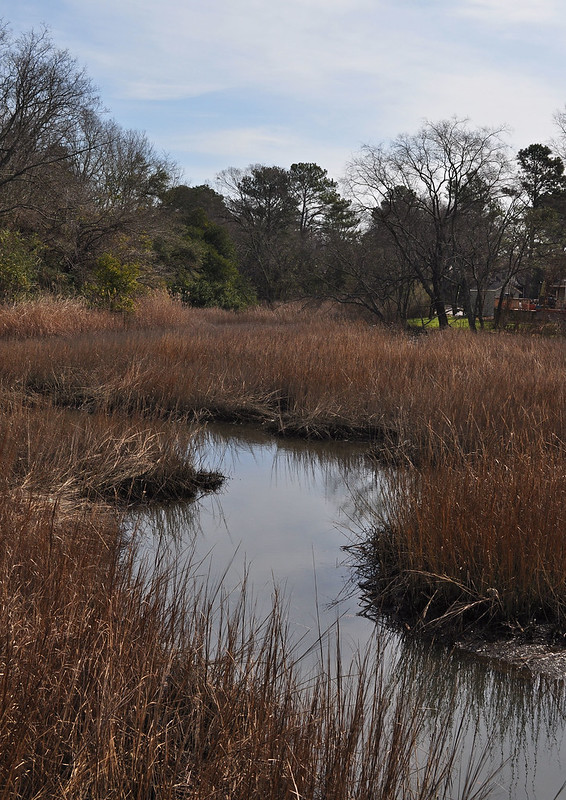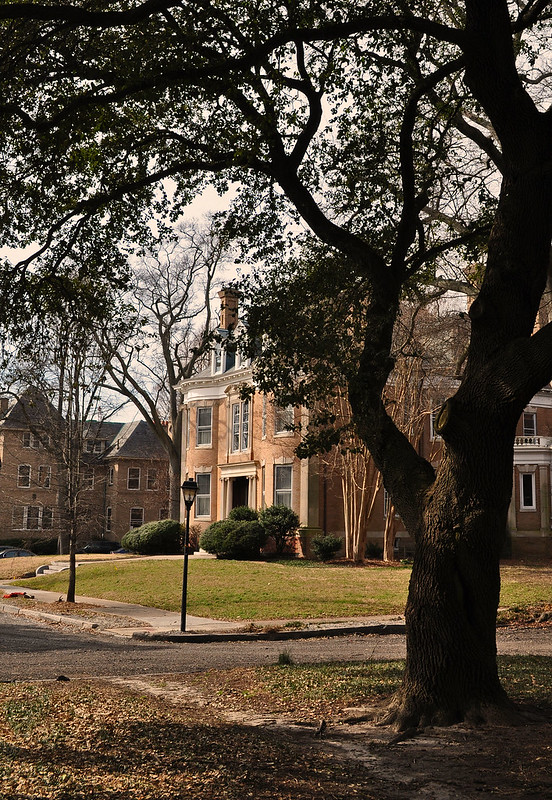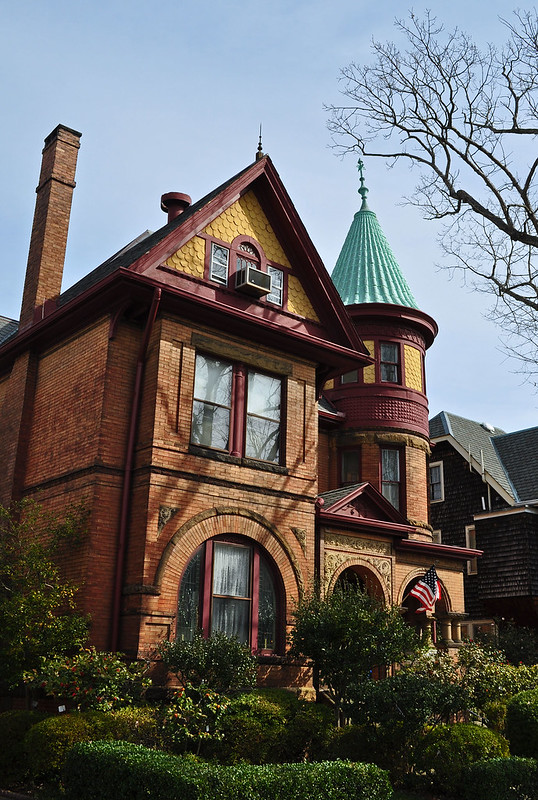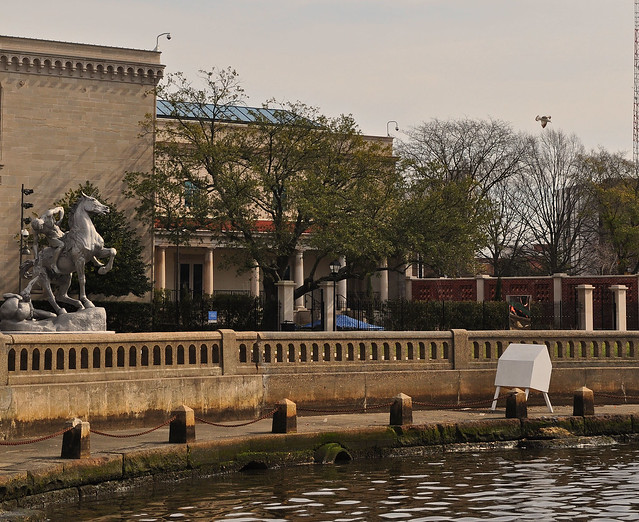February 28, 2016
Summer Color 2015 II
This is the second part of a review of what my team and I designed and planted at the Norfolk Botanical Garden last summer, part one is here. One of the plantings I was most pleased with were the containers in front of our Administration Building. The bromeliad is Aechmea blanchetiana, and I love the color it turns in the sun. It was combined with Tradescantia pallida 'Purple Heart', Dichondra 'Silver Falls', and vinca 'Cora Lavender' (Catharanthus roseus), which was more pink than lavender, but like others from the Cora series resisted the funk that vincas can get in periods of heavy summer rain.
On the backside of the same building, surrounding a fountain, we planted Cordyline 'Red Sensation', more Tradescantia pallida 'Purple Heart', surprisingly durable and florific Crossandra 'Orange Marmalade', and a new coleus (Plectranthus scutellarioides 'Henna'), which did very well for us.
There are few petunias that do well for us all season, but one that has is 'African Sunset'. We used it at the Café, along with 'Sedona' coleus (Plectranthus scutellarioides 'Sedona'), Solanum integrifolium (a.k.a pumpkin-on-a-stick), coral Stachytarpheta, and yet more Tradescantia (I may have to impose limits on myself with this plant). On the adjacent patio we filled pots with some of the same plants, and anchored them with 'New Zealand' castor bean (Ricinus communis) and foxtail palms (Wodyetia bifurcata), which were lousy anchors as they caught the wind and the pots blew over several times.
At the entrance to our Tropical Garden we used more of the Cordyline 'Red Sensation', Asclepias 'Silky Gold', golden shrimp plant (Pachystachys lutea), 'Black Pearl' ornamental pepper (Capiscum annuum 'Black Pearl'), a red New Guinea impatiens (Impatiens hawkeri), 'Macho' fern (Nephrolepis biserrata 'Macho'), and 'Marguerite' sweet potato vine (Ipomoea batatas 'Marguerite').
For the bed in front of our Children's Garden, the horticulturist responsible for that area created a family from clay pots, enjoying a picnic, including the family dog and a bird. I couldn't believe how many parents stood there and watched their children walk right into the bed to touch the pot people - or worse. Until the plants filled in thickly, she had to repair the creations constantly. No home training! Anyway, I can't remember all that went into this bed, but I do know it included Ageratum (probably 'Hawaii Blue'), Melampodium, an upright Celosia, cape plumbago (Plumbago auriculata), Echinacea 'Pow Wow', Dahlia 'Mystic Fantasy', and a dwarf yellow Cosmos.
Despite its location in our Perennial Garden, the channels that radiate from the central fountain are always planted with annuals. Last summer we used an odd mix of plants, most of which are more commonly known as edible or commercial crops. The planting included 'Black Madras' rice (Oryza sativa 'Black Madras'), red okra (Abelmoschus esculentus), roselle hibiscus (Hibiscus sabdariffa). black-leaved cotton (Gossypium herbaceum 'Nigra'), ornamental peanut (Arachis pointoi 'Golden Glory'), coleus 'Gay's Delight' (Plectranthus scutellarioides 'Gay's Delight'), and a new for us vinca, 'Jams 'N Jellies Blueberry' (Catharanthus roseus), which didn't look like its picture and didn't play very well with the other colors.
The only garden that disappointed me last year was the Circle Garden. We had carefully selected a color scheme, and a key component was a particular Torenia, and at the last minute our plug supplier could not supply, so we had to take a substitution that threw the whole thing off. However, I loved the 'Lime Zinger' elephant ears (Xanthosoma aurea 'Lime Zinger'). Every time I entered the garden I thought I was catching a glimpse of the South Pacific.
I have one more group of photos from last summer which will show our bridge baskets, and some succulent plantings which came out really well. I will post these later. Until then, if the weather is nice and you feel like a taking a stroll with your camera, I would love to see you enter my 2016 Winter Walk-Off.
February 21, 2016
Winter Walk-Off 2016
It's time once again for my annual Winter Walk-Off, and this year marks the 5th anniversary of this little meme of mine. Lately I seem to have trouble finding the time to blog, so I had momentarily considered not holding a Winter Walk-Off at all, but then thought better. I am also having trouble walking great distances right now; an aging body has made its presence known in my right knee, and I've had everything medically done do it short of replacement. However, I can still ride a bike unhindered, and that is precisely how this year's event was celebrated. I do hope you will join in, on foot or on pedal. I would love to catch a glimpse of the world as you see it.
As always, the rules are simple, the rules are flexible:
On your own two feet, leave the house, and share what can be seen within walking (or biking) distance of your home (if you want to drive to your walk destination that's OK too). Your post does not have to be about gardening or a travelogue (though I do like both), unless you want it to be. Maybe instead you will find some unusual patterns, interesting shadows, signs of spring, a favorite restaurant or shop, questionable landscaping, or local eyesores. Whatever, just keep your eyes and mind open, be creative, and have fun, but don't show anything from your own garden.
Post your own Winter Walk-Off on your blog, and link it back to this post. Also, please leave me a link and comment here when your post is up. If you have recently written something similar, you are welcome to recycle.
I will keep the challenge open until midnight on March 19th, the last day of winter (or summer for those of you below the equator, who are welcome to join in).
Everyone who participates will have a chance to win one of two prizes, and a totally disinterested teenager will randomly draw the winning names (if the totally disinterested teenager and I are ever home and awake at the same time). One participant will win a box of assorted treasures pulled from the Atlantic. The other winner will receive a different prize, as soon as I figure out what that will be. Surprises are good. I will contact each winner, and mail the prizes after the Walk-Off is over.
I hope these guidelines are simple enough to sway you to join in, because the more, the merrier.
As always, the rules are simple, the rules are flexible:
*****
In the middle of West Ghent is a small park whose centerpiece is a 350 year old live oak (Quercus virginiana). The tree and park were dedicated to those who died in "the World War", back when it didn't seem necessary to number wars. The tree is no Angel Oak, and it is in rough shape, but still a marvel.
As I left West Ghent I passed by another small park dedicated to victims of the Yellow Fever epidemic of 1855 which killed 2000 people, many of whom are buried here in a mass grave.
Heading into Ghent proper, I made my way to Stockley Gardens, which is more park than garden. Nearby and along the edge of the park are some of the city's most beautiful houses of worship, and even though I rarely step through their doors, I do admire sacred architecture.
Norfolk is home to a diverse and thriving Jewish community. The city's first Reform congregation was Ohef Sholom (Lovers of Peace), and when it came time to build a new synagogue they chose a site overlooking Stokley Gardens. The choice of neo-classical architecture projected the congregation's desire to be accepted as one part of a larger community, and not as something exotic or foreign. Written above the columns in English is "My House Shall be Called a House of Prayer For All Peoples".
Despite a plethora of temples and churches, when it came time for my wife and I to marry, we chose Beechwood Park, under a live oak, within a circle of stone.
Beechwood Park lies in the middle of The Hague, Ghent's oldest neighborhood, and is home to some fine residential architecture.
You would think that the house below was vintage, but it is only a few years old, built high because The Hague floods regularly. In fact, with the exception of New Orleans, Norfolk is more at risk from sea level rise than any other American city. Not content to let fate take its toll, the issue is forefront at city hall, at Naval Station Norfolk, and at local universities. The issue is also inspiration for local artist, Christopher Revels' Walking Houses project.
Heading home now, I passed Maury High School where my son is a senior, and where my wife, her mother, and my wife's grandmother all graduated. Named for Matthew Fontaine Maury, "Pathfinder of the Seas", a prominent wave motif is incorporated into the building's exterior. On the adjacent street and sidewalk, seniors let the world know where their intended post-graduate loyalties will lie.
Crossing the tracks, my final stop was L. Chenmen's where old navigational buoys line their salvage yard. I wonder how one or two of these would look in my garden.
Well I hope I haven't maxed out your allotment of pixels or bandwidth with this post. Sometimes I don't know when to stop. I do hope you will show a similar lack of restraint with your Winter Walk-Off, and I look forward to seeing your entry.
For this year's Walk-Off I rode through the Ghent section of Norfolk, which lies roughly between downtown and the Norfolk Southern railroad tracks. A thick verge of trumpet vine (Campsis radicans) and perhaps a fence somewhere hidden under those vines separate the tracks from my first stop, Robertson Park, a small park with big trees,
I then stopped at Weyanoke Sanctuary, which is a remnant natural area wedged between the massive rail yard and the neighborhood of West Ghent. The sanctuary's volunteers have done a remarkable job of reigning in a who's who of invasive species (Hedera helix, Vinca major, Lonicera japonica, Ligustrum sinensis, Arum italicum) in favor of natives. Their work is ongoing.
In the middle of West Ghent is a small park whose centerpiece is a 350 year old live oak (Quercus virginiana). The tree and park were dedicated to those who died in "the World War", back when it didn't seem necessary to number wars. The tree is no Angel Oak, and it is in rough shape, but still a marvel.
As I left West Ghent I passed by another small park dedicated to victims of the Yellow Fever epidemic of 1855 which killed 2000 people, many of whom are buried here in a mass grave.
Heading into Ghent proper, I made my way to Stockley Gardens, which is more park than garden. Nearby and along the edge of the park are some of the city's most beautiful houses of worship, and even though I rarely step through their doors, I do admire sacred architecture.
Norfolk is home to a diverse and thriving Jewish community. The city's first Reform congregation was Ohef Sholom (Lovers of Peace), and when it came time to build a new synagogue they chose a site overlooking Stokley Gardens. The choice of neo-classical architecture projected the congregation's desire to be accepted as one part of a larger community, and not as something exotic or foreign. Written above the columns in English is "My House Shall be Called a House of Prayer For All Peoples".
Despite a plethora of temples and churches, when it came time for my wife and I to marry, we chose Beechwood Park, under a live oak, within a circle of stone.
Beechwood Park lies in the middle of The Hague, Ghent's oldest neighborhood, and is home to some fine residential architecture.
You would think that the house below was vintage, but it is only a few years old, built high because The Hague floods regularly. In fact, with the exception of New Orleans, Norfolk is more at risk from sea level rise than any other American city. Not content to let fate take its toll, the issue is forefront at city hall, at Naval Station Norfolk, and at local universities. The issue is also inspiration for local artist, Christopher Revels' Walking Houses project.







